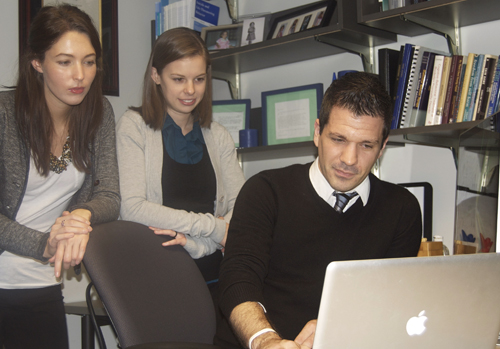Story by Vanessa Perkins, a U of G student writer with SPARK (Students Promoting Awareness of Research Knowledge)
Psychology professors Margaret Lumley and Stephen Lewis are drawing on years of mental health research by colleagues at U of G and other research institutions to help them understand the risk factors associated with depression and non-suicidal self-injury. They are developing an online program to provide intervention strategies that will help prevent mood problems and self-injury in at-risk youth.
Over the past 15 years, non-suicidal self-injury has become a significant issue in young people. It occurs when someone hurts their own body without the intent to end his or her life. The most common form of self-injury is cutting the skin.
Rates of non-suicidal self-injury consistently range from 14 to 24 per cent in teens and university students. The behaviour is often associated with mental health difficulties.
Lewis has found that many young people who self-injure would turn first to the Internet to seek help. “Teens use the Internet more than any other age group, which makes online intervention programs not only innovative, but relevant,” he says.
For her part, Lumley has been studying how to more effectively identify people experiencing depression in its early stages during the transition to adolescence. She estimates about one-fifth of adolescents experience an episode of major depression prior to adulthood. And those who experience depression as youth are more likely to experience a more serious course of the illness later in life, underlining the need to create better coping mechanisms for teens.
To help illuminate what leads to depression and non-suicidal self-injury, the researchers are using lab-based computer tasks that indirectly assess people’s responses to stimuli related to these mental health issues. And they’re finding that core beliefs are more important in predicting depression than previously believed.
“So much research has focused on the associations between negative beliefs, depression and thoughts of suicide,” says Lumley. “Our research also focuses on positive self-views and how these relate to mental illness and emotional resilience.”

New evaluation and intervention methods are particularly important because many of those who self-injure do not seek professional help, and some never tell anyone about it. Lumley and Lewis see the enormous potential that the Internet can provide as a research tool for understanding troubled youth who do not seek professional help.
That potential is driving their efforts toward interactive website development. “The Internet is available in the daily lives of most teens. They can access the Internet from home, school, and at any time on their cell phones,” says Lewis. “At the same time, the nature of content accessed is not always accurate and, in some cases, may be harmful.”
Lewis and other researchers have found a particularly troubling increase in self-injury-related themes in the media. Over the past five years, there’s been a significant increase in the number of message boards, websites and videos about non-suicidal self-injury posted on the Internet. Many of these do not have overt statements against self-injury, and researchers have suggested that this material − which is often portrayed in an artistic manner − may trigger the behaviour in those who access it.
The researchers say “triggering” is a new phenomenon, whereby viewing or reading about non-suicidal self-injury may increase thoughts and urges to self-injure, and perhaps the act of self-injury itself.
To better understand self-injury, Lewis is examining it on the Internet. He’s also involved in research examining cognitions among those who self-injure: how they cope with stress, why they self-injure and what their family experiences have been. He adds that an important factor involved in self-injury is difficulty coping with negative emotions.
To help youth build their emotional resilience, Lumley and Lewis are developing an online program to explain research-supported techniques on how to cope more positively with stress. Included are tasks that help individuals recognize their moods, challenge their regular thinking mechanisms and build on positive thought processes.
The program will be personalized for each user. Online visitors will be able to write in a diary and provide themselves with reminders to use the online material. “We will be able to track their usage and interview certain individuals to gain an even deeper understanding of their behaviour,” says Lumley. “We’re confident the website will be a step in the right direction to reach out to those who in need.”
Funding for this research was provided in part by the Ontario Mental Health Foundation New Investigator Fellowship.
